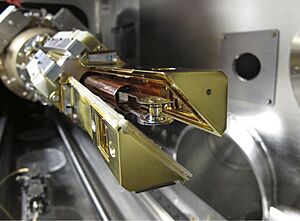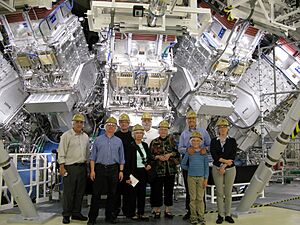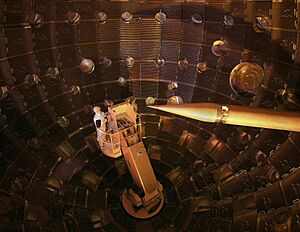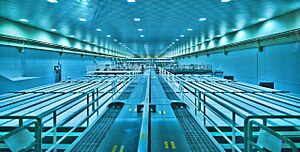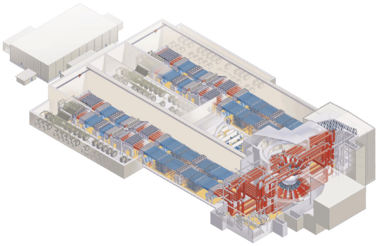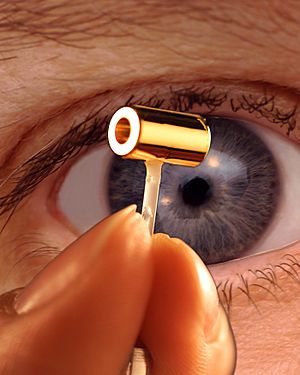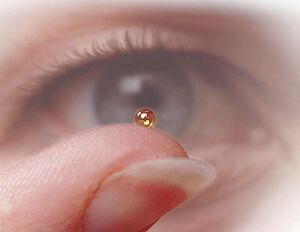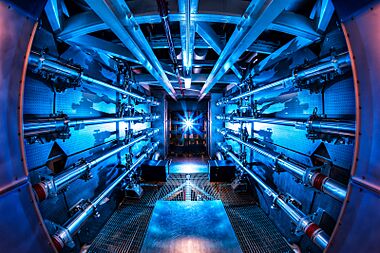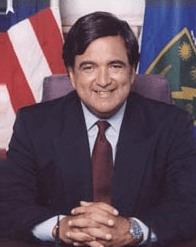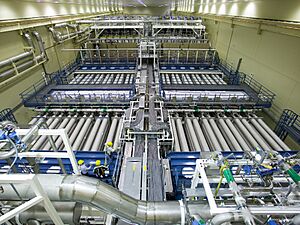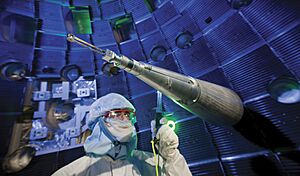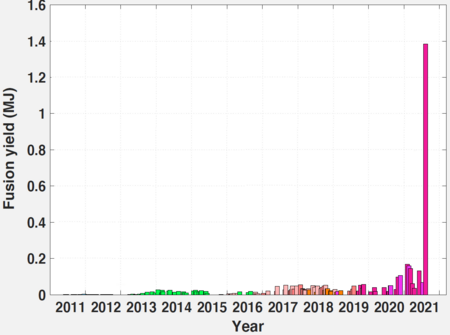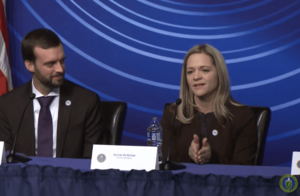National Ignition Facility facts for kids
The National Ignition Facility (NIF) is a giant laser lab located in Livermore, California, in the United States. Scientists there use powerful lasers to study something called inertial confinement fusion (ICF). Their main goal is to create fusion ignition, which is like making a tiny star on Earth.
NIF is the biggest and strongest ICF machine ever built. The idea behind ICF is to squeeze a very small amount of fuel. This squeezing makes the fuel hot and dense enough for fusion to happen. NIF has the world's most powerful laser. This laser heats the outside of a tiny sphere. The energy is so strong that it makes the sphere explode inwards. This explosion squeezes the fuel inside.
The implosion reaches a super-fast speed of 350 kilometers per second. This makes the fuel much denser than water, even denser than lead. The extreme heat and pressure make the fuel reach hundreds of millions of degrees. At these temperatures, tiny fusion reactions happen. This all takes place in a very short time before the fuel bursts outwards.
Construction of NIF started in 1997. It was finished on March 31, 2009. The first big experiments happened in June 2009. In 2021, NIF set a record by producing 70% of the laser's energy as fusion energy. Then, on December 5, 2022, NIF achieved "ignition" for the first time. This means it produced more energy from fusion than the laser put into the target. It made 3.15 megajoules of energy from 2.05 megajoules of laser input. This was a huge scientific step!
Contents
- How Inertial Confinement Fusion Works
- NIF's Design
- NIF's History
- Early Ideas, 1957
- ICF Program, 1970s
- Halite and Centurion, 1978
- Laboratory Microfusion Facility and Nova Upgrade, 1990
- NIF, 1994
- Building the First Unit, 1994–1998
- Re-evaluation and GAO Report, 1999–2000
- Tests and Construction Completion, 2003–2009
- Operations, 2009–2012
- DOE Report, July 19, 2012
- Fuel Gain Breakeven, 2013
- Stockpile Experiments, 2013–2015
- Back to Fusion, 2016–Present
- Burning Plasma Achieved, 2021
- Scientific Breakeven Achieved, 2022
- Similar Projects
- Images for kids
- See also
How Inertial Confinement Fusion Works
Inertial confinement fusion (ICF) machines use a lot of energy to quickly heat a small target. This heating makes the target compress. In NIF, powerful lasers are used for this.
The target is a tiny ball, like a small pellet. It holds a few milligrams of fusion fuel. This fuel is usually a mix of deuterium (D) and tritium (T). These are special types of hydrogen that fuse easily.
Many laser beams hit the surface of the pellet. This turns the surface into a hot gas called plasma. This plasma explodes away from the surface. This pushes the rest of the pellet inwards from all sides. It squeezes the fuel into a very small, super-dense spot.
The explosion creates shock waves that travel inwards. At the center of the fuel, a tiny area gets even hotter and more compressed. When the temperature and density are high enough, fusion reactions begin. The energy from the lasers must hit the target very quickly and evenly. This is important to squeeze the fuel perfectly.
The fusion reactions release high-energy particles. Some of these particles, especially alpha particles, hit other fuel particles. This heats the fuel even more. This extra heating can cause more fusion reactions. This process is called bootstrapping. If the conditions are right (high density, temperature, and enough time), bootstrapping can lead to a chain reaction. This chain reaction spreads outwards from the center. This is called ignition. Ignition fuses a lot of the fuel and releases a huge amount of energy.
NIF's Design
The System
NIF uses a method called "indirect drive." This means the laser doesn't hit the fuel directly. Instead, the laser heats a small metal cylinder. This cylinder is called a hohlraum (which means "hollow room" in German). The fuel pellet is inside this hohlraum.
When the lasers hit the hohlraum, it gets super hot. It then re-emits the energy as very high-frequency X-rays. These X-rays are spread out more evenly. This helps to compress the fuel pellet very symmetrically.
The fuel pellet is about 2 millimeters wide. It's cooled to a super cold temperature, about 18 kelvin (which is -255 degrees Celsius). It has a layer of frozen deuterium-tritium (DT) fuel. The hollow inside contains a small amount of DT gas.
In a typical experiment, the laser creates about 3 megajoules of infrared laser energy. After converting it to UV light, about 1.5 megajoules remain. Some energy is lost in the hohlraum. About 150 kilojoules of X-rays are absorbed by the target's outer layers. In the end, only about 10 to 14 kilojoules of energy actually reach the fuel.
The fuel in the center of the target is squeezed to an incredible density. It becomes about 1000 grams per cubic centimeter. To compare, lead is only about 11 grams per cubic centimeter. The pressure inside is like 300 billion atmospheres!
Scientists hoped that about 20 megajoules of fusion energy would be released. This would mean a gain of about 15 times the UV laser energy. With improvements, they hope to get up to 100-150 megajoules of fusion energy. The target chamber is designed to handle a maximum of about 45 megajoules of fusion energy. This is like 11 kilograms of TNT exploding.
The Laser
NIF aims to create a single, super-powerful flash of light. This flash can reach 500 terawatts (TW) at its peak. It hits the target from many directions within a few picoseconds (a picosecond is a trillionth of a second!). The system uses 192 laser beams. These lasers are powered by flashlamps and use special glass.
To make sure all beams are uniform, the laser starts from one source. This is called the Injection Laser System. It begins with a low-power flash of infrared light. This light is then split and sent into 48 Preamplifier Modules (PAMs). Each PAM makes the light much stronger.
The main amplification happens in large glass amplifiers. Before firing, these amplifiers are "pumped" by 7,680 flash lamps. These lamps get their power from a huge capacitor bank that stores 400 megajoules of energy. When the laser light passes through the amplifiers, they release their stored energy into the beam. The beams go through the main amplifiers four times. This boosts the original 6 joules of light to about 4 megajoules. Because this happens in just a few nanoseconds, the peak power reaching the target is 500 TW.
Along the laser path, there are "spatial filters." These are long tubes with small telescopes. They focus the beam to a tiny point. A mask at this point blocks any stray light. This makes sure the laser beam is very uniform.
The total path the laser beam travels is about 1,500 meters (almost a mile!). The different parts of the laser are in standardized boxes. These boxes can be easily replaced if needed.
After being amplified, the light travels to the target chamber. The target chamber is a 10-meter-wide steel sphere. It weighs 130,000 kilograms. Before hitting the target, mirrors reflect the light. This makes sure the beams hit the target from different directions. The timing is super precise. All beams must reach the center within a few picoseconds of each other.
One of the last steps is to change the infrared (IR) laser light into ultraviolet (UV) light. This happens in a "frequency converter." These are thin sheets of special crystals. When the IR light passes through them, it changes into UV light. UV light is much better at heating the targets. The conversion process is about 50% efficient. This means the energy delivered to the target is about 1.8 megajoules.
A key goal for NIF was to allow experiments to happen quickly. Older laser systems needed many hours to cool down. NIF aims to reduce this time to less than four hours. This allows for about 700 firings a year.
Other Ideas
NIF is also trying out new types of targets. Earlier experiments used plastic materials. NIF targets are now made by coating a plastic form with beryllium. Beryllium targets are better at absorbing X-rays. This makes the implosion more efficient.
Even though NIF was designed for indirect drive, its lasers are powerful enough for "direct drive." In direct drive, the laser shines right onto the target. This could lead to even higher fusion energy gains.
Scientists are also looking at "polar direct drive." Here, the laser hits the target only from the top and bottom. Other targets, called "saturn targets," have a small plastic ring around the middle. This ring helps to spread the laser light more evenly.
NIF's History
Early Ideas, 1957
The idea for ICF at Lawrence Livermore National Laboratory began with physicist John Nuckolls. He started thinking about it after a meeting in 1957. At that time, they were thinking about using small hydrogen bombs in caverns to make steam for electricity. Nuckolls wondered how small a bomb could be made to still produce energy.
A hydrogen bomb has two main parts. A small fission bomb (the "primary") and a cylinder of fusion fuels (the "secondary"). The primary releases X-rays. These X-rays heat and compress the secondary until it fuses. Nuckolls wanted to see how small the secondary could be. He thought about replacing the fuel with a mix of deuterium and tritium gas. This would remove the need for a "spark plug" inside. As the secondary shrinks, less energy is needed for fusion. At very small sizes, the energy needed started to match what could be done with other devices.
By the early 1960s, Nuckolls and other scientists had the basic ideas for ICF. The fuel would be in a small capsule. This capsule would quickly vaporize when heated. This would maximize the squeezing and shock waves. The capsule would be placed inside a shell, the hohlraum. The hohlraum would act like the bomb casing. Any energy source could heat the hohlraum to produce X-rays. Computer simulations suggested that about 5 megajoules of energy would be needed from the primary.
ICF Program, 1970s
While Nuckolls worked on hohlraum-based ideas, another physicist, Keith Brueckner, worked on "direct drive." In the early 1970s, Brueckner started a company to use this idea. This created a lot of competition. ICF became a very popular topic. Many labs started ICF research. LLNL focused on glass lasers.
In these early stages, much of the understanding came from computer simulations. One program, LASNEX, suggested that smaller lasers could achieve low energy gain. This led to the Shiva laser project, finished in 1977. But Shiva didn't meet its goals. The fuel densities were much lower than predicted. This was because of how the laser delivered heat. Most of its energy went to electrons, not the whole fuel. Later experiments showed that using shorter laser wavelengths could improve this.
More advanced simulations predicted that a different design could reach ignition. This led to the Nova laser, a 20-beam, 200 kilojoule system. But during construction, an error was found. Nova would not reach ignition. It was changed to a smaller 10-beam design. This design converted the light to UV. Nova could deliver about 30 kilojoules of UV laser energy. Even at these levels, fusion yields were much lower than expected.
Halite and Centurion, 1978
Each experiment showed that the energy needed for ignition was always underestimated. The Department of Energy (DOE) decided to do direct experiments. In 1978, they started tests at the Nevada Test Site. These tests used small nuclear bombs to light up ICF targets underground. These tests were called Halite and Centurion.
The idea was to place targets in long tunnels. Fast-closing doors would protect them from the bomb's blast. The ICF tests used the same system. They replaced the original targets with hohlraums. Each test lit up many targets at once. This helped them see how different amounts of light affected them. They also wanted to know how big the fuel assembly needed to be for the fuel to self-heat and ignite.
Data from these tests was available by mid-1984. Testing stopped in 1988. Ignition was achieved for the first time during these tests. The energy and fuel size needed for ignition were much higher than predicted. Experiments on Nova also used similar targets. This allowed direct comparisons between laser tests and bomb tests.
This data suggested that about 10 megajoules of X-ray energy would be needed for ignition. This was far more than earlier calculations. If these X-rays came from an infrared laser hitting a hohlraum, then much more laser energy would be needed, around 100 megajoules.
This led to a big discussion. Some suggested building a 100-megajoule laser. Others used new computer simulations. They thought that carefully shaping the laser pulse and using more beams could achieve ignition with 5 to 10 megajoules of laser energy.
The DOE then asked for a special military ICF facility. It was called the "Laboratory Microfusion Facility" (LMF). LMF would use a driver of about 10 megajoules. It would produce fusion yields between 100 and 1,000 megajoules. A review in 1989-1990 said LMF was too ambitious. They recommended more experiments before building a 10-megajoule system.
Laboratory Microfusion Facility and Nova Upgrade, 1990
By 1992, the LMF was estimated to cost about $1 billion. LLNL first proposed a design with a 5 megajoule UV laser. This laser would produce about 200 megajoules of fusion energy. This was enough for most of the LMF goals. This program was estimated to cost about $600 million. An extra $250 million would upgrade it to a full 1,000 megajoules. The total would be over $1 billion.
The review led to new plans. In July 1990, LLNL proposed the Nova Upgrade. It would reuse most of the existing Nova and Shiva facilities. The new system would be less powerful than LMF, with about a 1 megajoule laser. It included new features like multi-pass amplifiers. It would have 18 beamlines, split into 288 "beamlets." The lasers would deliver about 500 TW in a 4 nanosecond pulse. These upgrades were expected to produce 2 to 10 megajoules of fusion energy. Initial estimates in 1992 put construction costs at around $400 million. Construction was planned from 1995 to 1999.
NIF, 1994
During this time, the end of the Cold War changed defense funding. Support for nuclear weapons decreased. The Comprehensive Nuclear-Test-Ban Treaty (CNTB) was signed in 1996. This banned all nuclear weapons testing.
These changes led to the Stockpile Stewardship and Management Program (SSMP). This program included money to design and build nuclear weapons without explosive testing. In 1995, an agreement was made to divide SSMP efforts. A key part was to confirm computer models using low-yield ICF experiments. The Nova Upgrade was too small for these experiments. A new design became NIF in 1994. The estimated cost was almost $1 billion, with completion in 2002.
Despite the agreement, the high cost led to criticism. Scientists at other labs, like Sandia National Laboratories, had concerns. In 1997, a Sandia scientist said NIF had "virtually no internal peer review." A retired Sandia manager called NIF "worthless." Ray Kidder, one of the original ICF developers, was also critical. He said NIF's main purpose was to "recruit and maintain a staff of theorists and experimentalists."
In 1997, Victor Reis, a DOE official, defended NIF. He told Congress that NIF was "designed to produce, for the first time in a laboratory setting, conditions of temperature and density of matter close to those that occur in the detonation of nuclear weapons." He said this was key to understanding nuclear weapons without underground testing. In 1998, scientific experts said NIF was the most valuable program for science-based stockpile stewardship.
Even with initial criticism, Sandia and Los Alamos labs supported NIF. They later became partners in the National Ignition Campaign.
Building the First Unit, 1994–1998
Work on NIF started with a single beamline test, called Beamlet. Beamlet worked successfully from 1994 to 1997. The official groundbreaking for NIF was on May 29, 1997.
At that time, the DOE estimated NIF would cost about $1.1 billion. They thought it would be finished by 2002. Later in 1997, the DOE approved more funding. They pushed the completion date to 2004. By 1998, LLNL said the price was $1.2 billion. They expected the first eight lasers to be online in 2001 and full completion in 2003.
The sheer size of the facility made construction tough. By 2001, when the main building was done, a lot of soil had been dug up. A huge amount of concrete and steel was used. To protect the laser system from vibrations, each laser bay's foundation was separate from the rest of the building.
In November 1997, a big storm flooded the NIF site. This delayed construction. In December 1997, 16,000-year-old mammoth bones were found. Paleontologists were called in, delaying work for four days.
Many challenges came up during development. They had to create special optics (laser glass) for NIF's 7,500 large optics. New ways to measure, coat, and finish optics were developed. These optics needed to withstand NIF's powerful lasers. They also developed new ways to amplify the laser beams.
Sandia designed the capacitor banks that power the flashlamps. The first unit was done in October 1998. But the capacitor banks had problems. This required redesigns. These problems caused more delays. In September 1999, a DOE report said NIF needed up to $350 million more. It also said completion would be in 2006.
Re-evaluation and GAO Report, 1999–2000
Problems with NIF were not always reported to higher management. In 1999, the Secretary of Energy, Bill Richardson, told Congress that NIF was on time and budget. But this was not true. The Government Accountability Office (GAO) later reported that NIF had "serious problems." A DOE Task Force in January 2000 said that NIF management failed. They said "no one gets a passing grade on NIF Management."
Because of budget problems, Congress asked for an independent GAO review. In August 2000, they released a critical report. It estimated the cost would be $3.9 billion. It said the facility would not be finished on time. The report blamed management problems for the overruns.
In 2000, the DOE started a "rebaseline review." They adjusted the schedule and budget. John Gordon, a nuclear security administrator, said NIF management had made progress. The report revised the budget to $2.25 billion. This didn't include related research, which pushed the total to $3.3 billion. The completion date was pushed to 2006. A report the next year pushed the budget to $4.2 billion and completion to 2008.
NIF got a new management team in September 1999. Ed Moses became the NIF project manager. After this, NIF management received many good reviews. The project met the budgets and schedules approved by Congress. In October 2010, the project was named "Project of the Year."
Tests and Construction Completion, 2003–2009
In May 2003, NIF achieved "first light" on four beams. It produced a 10.4 kilojoule infrared pulse. In 2005, the first eight beams produced 153 kilojoules of infrared light. This made NIF the highest energy laser per pulse on Earth. By January 2007, all main parts of the laser were complete. By August 2007, 96 laser lines were finished. More than 2.5 megajoules of infrared energy had been fired. This was 40 times more than the Nova laser.
In 2005, an independent review was positive. But it said that achieving ignition in 2010 was "unlikely." On January 26, 2009, the last major part was installed. On February 26, 2009, NIF fired all 192 laser beams into the target chamber. On March 10, 2009, NIF became the first laser to break the megajoule barrier. It delivered 1.1 megajoules of UV light to the target. The main laser delivered 1.952 megajoules of infrared light.
Operations, 2009–2012
On May 29, 2009, NIF was officially opened. The first laser shots into a hohlraum target happened in late June.
Building Up to Main Experiments, 2010
On January 28, 2010, NIF delivered a 669 kilojoule pulse to a gold hohlraum. This set new records for laser power. Analysis suggested that plasma interference would not stop a fusion reaction.
Scientists gradually changed the laser's wavelength. They compressed a spherical capsule evenly. They heated it to 3.3 million kelvins. The capsule had super-cooled gas inside. This gas was a substitute for the real deuterium and tritium fuel.
By January 2010, NIF reached 1.8 megajoules. The target chamber then needed shields to block neutrons.
National Ignition Campaign 2010–2012
With construction done, NIF started its National Ignition Campaign (NIC). The goal was to reach ignition. Science magazines said ignition was coming soon.
The first test was on October 8, 2010, at just over 1 megajoule. But problems slowed the progress toward ignition-level laser energies.
One problem was potential damage from overheating optical parts. Other issues included problems with layering the fuel inside the target. Tiny amounts of dust on the capsule surface also caused issues.
The power level kept increasing. Targets became more complex. Then, tiny amounts of water vapor appeared in the target chamber. They froze onto the hohlraums' windows. This caused the implosion to be uneven. They solved this by adding a second layer of glass.
Shots stopped from February to April 2011 for other experiments. Then, NIF was upgraded. Diagnostic and measurement tools were improved. The Advanced Radiographic Capability (ARC) system was added. This system uses 4 of NIF's 192 beams to image the implosion. ARC is a super-powerful laser. It can create very short laser pulses to produce high-energy X-rays.
NIC runs restarted in May 2011. The goal was to time the four laser shock waves more precisely. These waves compress the fusion target.
In January 2012, Mike Dunne, NIF's laser fusion energy program director, predicted ignition by October. In the same month, NIF fired a record 57 shots. On March 15, NIF produced a laser pulse with 411 TW of peak power. On July 5, it produced a shorter pulse of 1.85 MJ and increased power of 500 TW.
DOE Report, July 19, 2012
The NIC was reviewed regularly. The 6th review was published on July 19, 2012. The report praised the quality of the NIF's equipment. But it said: "The conclusion... is that considerable hurdles must be overcome to reach ignition... the probability of ignition before the end of December is extremely low."
The report also worried that the computer simulations were not accurate enough. They found problems predicting how radiation would drive the capsule. They also found issues with how the laser interacted with the plasma. The pressure reached was only half to one-third of what was needed for ignition. This was much lower than predicted. The report discussed how ablator material (from the outside of the capsule) mixed with the fuel. This was likely due to instabilities.
The report suggested using a thicker ablator. But this would make it harder to compress. To keep the implosion speed, they suggested increasing NIF's energy to 2 MJ. It questioned if the energy was enough to compress a large enough capsule to reach ignition. The report concluded that ignition in 2012 was "highly unlikely."
NIC officially ended on September 30, 2012. News reports suggested NIF would focus on materials research.
In 2008, LLNL started the Laser Inertial Fusion Energy (LIFE) program. This program explored using NIF technologies for a commercial power plant. The focus was on pure fusion devices. This program ended in April 2014.
Fuel Gain Breakeven, 2013
A NIF fusion shot on September 27, 2013, produced more energy than the deuterium–tritium fuel absorbed. This is sometimes confused with "scientific breakeven." Scientific breakeven means the fusion energy is more than the laser input energy. In this case, it was 14.4 kilojoules out from 1.8 megajoules in. This is a ratio of 0.008.
Stockpile Experiments, 2013–2015
In 2013, NIF focused on materials and weapons research. Experiments starting in 2015 used plutonium targets. Plutonium shots simulate how the primary in a nuclear bomb is compressed. This had not been directly tested since the nuclear test ban treaty. Plutonium amounts ranged from less than a milligram to 10 milligrams.
In 2014, NIF performed 191 shots. By April 2015, NIF was on track to meet its goal of 300 laser shots in 2015.
Back to Fusion, 2016–Present
On January 28, 2016, NIF did its first gas pipe experiment. This studied how large amounts of laser light are absorbed in targets. In 2018, they showed better control of compression. A shot produced 1.9×1016 neutrons. This resulted in 0.054 megajoules of fusion energy from a 1.5 megajoule laser pulse.
Burning Plasma Achieved, 2021
Experiments in 2020 and 2021 created the world's first burning plasmas. In these, most of the plasma heating came from the fusion reactions themselves. On August 8, 2021, they achieved the world's first ignited plasma. Here, the fusion heating was enough to keep the reaction going. It produced extra neutrons, showing a short chain reaction.
The fusion energy from the 2021 experiment was about 70% of the laser energy that hit the plasma. This beat the previous record of 67% set by the JET in 1997. If you consider the laser's own energy use, the experiment used about 477 megajoules of electricity. This produced 1.8 megajoules of energy into the target, which then created 1.3 megajoules of fusion energy.
Several changes helped achieve this. The capsule shell material was changed to diamond. This helped it absorb more X-rays. The surface was also made smoother. The tiny hole in the capsule for injecting fuel was made smaller. The holes in the gold cylinder around the capsule were shrunk to reduce energy loss. The laser pulse was also made longer.
Scientific Breakeven Achieved, 2022
NIF became the first fusion experiment to achieve scientific breakeven on December 5, 2022. An experiment produced 3.15 megajoules of energy from a 2.05 megajoule laser input. This was an energy gain of about 1.5 times. Charging the laser itself used "well above 400 megajoules" of electricity. On December 13, the Secretary of Energy, Jennifer Granholm, announced that the facility had achieved ignition. While this was a "net energy gain" from the fusion reaction itself, it's important to remember the large amount of electricity needed to power the lasers.
This achievement required a slightly thicker and smoother capsule around the fuel. The laser energy was also increased to 2.05 MJ (up from 1.9 MJ in 2021). They also spread the energy among the laser beams differently. This created a more symmetrical (spherical) implosion.
NIF achieved breakeven a second time on July 30, 2023. It yielded 3.88 MJ, an 89% surplus. At least four of six shots after December 2022 also achieved breakeven. These successes led the DOE to fund three more research centers. Lawrence Livermore plans to increase laser energy to 2.2 MJ per shot. They reached this on October 30, 2023.
Similar Projects
Here are some other experimental ICF projects:
- Laser Mégajoule (LMJ)
- Nike laser
- High Power laser Energy Research facility (HiPER)
- Laboratory for Laser Energetics (LLE)
- Magnetized liner inertial fusion (MagLIF)
- Shenguang-II High Power Laser
Images for kids
See also
- Z Pulsed Power Facility
- Chain reaction
- HiPER
- Inertial confinement fusion
- ITER
- Laser Mégajoule
- Nuclear fusion
- Nuclear reactor



